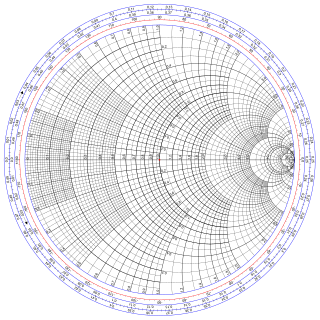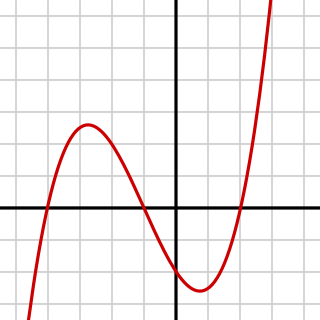
In probability theory and statistics, the exponential distribution is the probability distribution that describes the time between events in a Poisson point process, i.e., a process in which events occur continuously and independently at a constant average rate. It is a particular case of the gamma distribution. It is the continuous analogue of the geometric distribution, and it has the key property of being memoryless. In addition to being used for the analysis of Poisson point processes it is found in various other contexts.
In complex analysis, an elliptic function is a meromorphic function that is periodic in two directions. Just as a periodic function of a real variable is defined by its values on an interval, an elliptic function is determined by its values on a fundamental parallelogram, which then repeat in a lattice. Such a doubly periodic function cannot be holomorphic, as it would then be a bounded entire function, and by Liouville's theorem every such function must be constant. In fact, an elliptic function must have at least two poles in a fundamental parallelogram, as it is easy to show using the periodicity that a contour integral around its boundary must vanish, implying that the residues of all simple poles must cancel.
The Liouville function, denoted by λ(n) and named after Joseph Liouville, is an important function in number theory.

In mathematics, Weierstrass's elliptic functions are elliptic functions that take a particularly simple form; they are named for Karl Weierstrass. This class of functions are also referred to as p-functions and generally written using the symbol ℘. The ℘ functions constitute branched double coverings of the Riemann sphere by the torus, ramified at four points. They can be used to parametrize elliptic curves over the complex numbers, thus establishing an equivalence to complex tori. Genus one solutions of differential equations can be written in terms of Weierstrass elliptic functions. Notably, the simplest periodic solutions of the Korteweg–de Vries equation are often written in terms of Weierstrass p-functions.

The Smith chart, invented by Phillip H. Smith (1905–1987), is a graphical aid or nomogram designed for electrical and electronics engineers specializing in radio frequency (RF) engineering to assist in solving problems with transmission lines and matching circuits. The Smith chart can be used to simultaneously display multiple parameters including impedances, admittances, reflection coefficients, scattering parameters, noise figure circles, constant gain contours and regions for unconditional stability, including mechanical vibrations analysis. The Smith chart is most frequently used at or within the unity radius region. However, the remainder is still mathematically relevant, being used, for example, in oscillator design and stability analysis.
In mathematics, the Poincaré metric, named after Henri Poincaré, is the metric tensor describing a two-dimensional surface of constant negative curvature. It is the natural metric commonly used in a variety of calculations in hyperbolic geometry or Riemann surfaces.
In mathematics, the Gibbs measure, named after Josiah Willard Gibbs, is a probability measure frequently seen in many problems of probability theory and statistical mechanics. It is a generalization of the canonical ensemble to infinite systems. The canonical ensemble gives the probability of the system X being in state x as
In mathematics, a de Branges space is a concept in functional analysis and is constructed from a de Branges function.
In mathematics, Lindelöf's theorem is a result in complex analysis named after the Finnish mathematician Ernst Leonard Lindelöf. It states that a holomorphic function on a half-strip in the complex plane that is bounded on the boundary of the strip and does not grow "too fast" in the unbounded direction of the strip must remain bounded on the whole strip. The result is useful in the study of the Riemann zeta function, and is a special case of the Phragmén–Lindelöf principle. Also, see Hadamard three-lines theorem.
In mathematics, Doob's martingale inequality is a result in the study of stochastic processes. It gives a bound on the probability that a stochastic process exceeds any given value over a given interval of time. As the name suggests, the result is usually given in the case that the process is a non-negative martingale, but the result is also valid for non-negative submartingales.
In mathematics, an analytic semigroup is particular kind of strongly continuous semigroup. Analytic semigroups are used in the solution of partial differential equations; compared to strongly continuous semigroups, analytic semigroups provide better regularity of solutions to initial value problems, better results concerning perturbations of the infinitesimal generator, and a relationship between the type of the semigroup and the spectrum of the infinitesimal generator.
In complex analysis, given initial data consisting of points in the complex unit disc and target data consisting of points in , the Nevanlinna–Pick interpolation problem is to find a holomorphic function that interpolates the data, that is for all ,
In mathematics, the elliptic modular lambda function λ(τ) is a highly symmetric holomorphic function on the complex upper half-plane. It is invariant under the fractional linear action of the congruence group Γ(2), and generates the function field of the corresponding quotient, i.e., it is a Hauptmodul for the modular curve X(2). Over any point τ, its value can be described as a cross ratio of the branch points of a ramified double cover of the projective line by the elliptic curve , where the map is defined as the quotient by the [−1] involution.
In fluid dynamics, a flow with periodic variations is known as pulsatile flow, or as Womersley flow. The flow profiles was first derived by John R. Womersley (1907–1958) in his work with blood flow in arteries. The cardiovascular system of chordate animals is a very good example where pulsatile flow is found, but pulsatile flow is also observed in engines and hydraulic systems, as a result of rotating mechanisms pumping the fluid.
In orbital mechanics, a frozen orbit is an orbit for an artificial satellite in which natural drifting due to the central body's shape has been minimized by careful selection of the orbital parameters. Typically, this is an orbit in which, over a long period of time, the satellite's altitude remains constant at the same point in each orbit. Changes in the inclination, position of the lowest point of the orbit, and eccentricity have been minimized by choosing initial values so that their perturbations cancel out. This results in a long-term stable orbit that minimizes the use of station-keeping propellant.
In optics, the Fraunhofer diffraction equation is used to model the diffraction of waves when the diffraction pattern is viewed at a long distance from the diffracting object, and also when it is viewed at the focal plane of an imaging lens.
In mathematics, the Grunsky matrices, or Grunsky operators, are matrices introduced by Grunsky (1939) in complex analysis and geometric function theory. They correspond to either a single holomorphic function on the unit disk or a pair of holomorphic functions on the unit disk and its complement. The Grunsky inequalities express boundedness properties of these matrices, which in general are contraction operators or in important special cases unitary operators. As Grunsky showed, these inequalities hold if and only if the holomorphic function is univalent. The inequalities are equivalent to the inequalities of Goluzin, discovered in 1947. Roughly speaking, the Grunsky inequalities give information on the coefficients of the logarithm of a univalent function; later generalizations by Milin, starting from the Lebedev–Milin inequality, succeeded in exponentiating the inequalities to obtain inequalities for the coefficients of the univalent function itself. Historically the inequalities were used in proving special cases of the Bieberbach conjecture up to the sixth coefficient; the exponentiated inequalities of Milin were used by de Branges in the final solution. The Grunsky operators and their Fredholm determinants are related to spectral properties of bounded domains in the complex plane. The operators have further applications in conformal mapping, Teichmüller theory and conformal field theory.
In mathematics, in the field of complex analysis, a Nevanlinna function is a complex function which is an analytic function on the open upper half-plane H and has non-negative imaginary part. A Nevanlinna function maps the upper half-plane into itself, but is not necessarily injective or surjective. Functions with this property are sometimes also known as Herglotz, Pick or R functions.
The Hermite or Pólya class is a set of entire functions satisfying the requirement that if E(z) is in the class, then:
- E(z) has no zero (root) in the upper half-plane.
- for x and y real and y positive.
- is a non-decreasing function of y for positive y.
The Fokas method, or unified transform, is an algorithmic procedure for analysing boundary value problems for linear partial differential equations and for an important class of nonlinear PDEs belonging to the so-called integrable systems. It is named after Greek mathematician Athanassios S. Fokas.












































